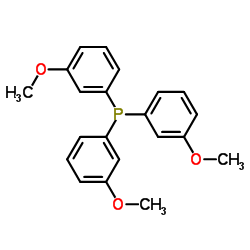29949-84-6
| 中文名 | 三(3-甲氧苯基)膦 |
|---|---|
| 英文名 | tris(3-methoxyphenyl)phosphane |
| 中文别名 |
三(3-甲氧基苯基)膦
三(3-甲氧基苯基)膦 |
| 英文别名 |
P(m-OMePh)3
Tris(m-methoxyphenyl)phosphine TRI(M-ANISYL)PHOSPHINE Tris(m-anisyl)phosphine Phosphine, tris(3-methoxyphenyl)- Tris(3-methoxyphenyl)phosphine MFCD00008386 tris(3-methoxy)phenylphosphine tris-(3-anisyl)phosphine |
| 沸点 | 476.3±40.0 °C at 760 mmHg |
|---|---|
| 熔点 | 113-115 °C(lit.) |
| 分子式 | C21H21O3P |
| 分子量 | 352.363 |
| 闪点 | 301.7±27.6 °C |
| 精确质量 | 352.122833 |
| PSA | 41.28000 |
| LogP | 5.44 |
| 外观性状 | 白色至近乎于白色结晶粉末 |
| 蒸汽压 | 0.0±1.1 mmHg at 25°C |
| 储存条件 | 保持贮藏器密封、储存在阴凉、干燥的地方,确保工作间有良好的通风或排气装置 |
| 稳定性 | 如果遵照规格使用和储存则不会分解,未有已知危险反应 避免氧化物 |
| 计算化学 | 1.疏水参数计算参考值(XlogP):4.5 2.氢键供体数量:0 3.氢键受体数量:3 4.可旋转化学键数量:6 5.互变异构体数量:无 6.拓扑分子极性表面积27.7 7.重原子数量:25 8.表面电荷:0 9.复杂度:334 10.同位素原子数量:0 11.确定原子立构中心数量:0 12.不确定原子立构中心数量:0 13.确定化学键立构中心数量:0 14.不确定化学键立构中心数量:0 15.共价键单元数量:1 |
| 更多 | 1. 性状:白色粉末 2. 密度(g/mL,20℃):未确定 3. 相对蒸汽密度(g/mL,空气=1):未确定 4. 熔点(ºC):113-115 5. 沸点(ºC,常压):未确定 6. 沸点(ºC,KPa):未确定 7. 折射率:未确定 8. 闪点(ºC):未确定 9. 比旋光度(º):未确定 10. 自燃点或引燃温度(ºC):未确定 11. 蒸气压(Pa,20ºC):未确定 12. 饱和蒸气压(KPa,25ºC):未确定 13. 燃烧热(KJ/mol):未确定 14. 临界温度(ºC):未确定 15. 临界压力(KPa):未确定 16. 油水(辛醇/水)分配系数的对数值:未确定 17. 爆炸上限(%,V/V):未确定 18. 爆炸下限(%,V/V):未确定 19. 溶解性:未确定 |
|
Section 1: Product Identification Chemical Name:Tris(m-methoxyphenyl)phosphine, 97+% CAS Registry Number:29949-84-6 Formula:(m-CH3OC6H4)3P EINECS Number:none Chemical Family:organophosphine ligand Synonym:Tris(3-methoxyphenyl)phosphine, Tri(m-anisyl)phosphine
Section 2: Composition and Information on Ingredients IngredientCAS NumberPercentACGIH (TWA)OSHA (PEL) Title compound29949-84-6100%no datano data Section 3: Hazards Identification Emergency Overview:Irritating to the respiratory tract, skin and eyes. May be harmful if swallowed. Primary Routes of Exposure:Ingestion, eyes, inhalation Eye Contact:Causes slight to mild irritation of the eyes. Skin Contact:Causes slight to mild irritation of the skin. Inhalation:Irritating to the nose, mucous membranes and respiratory tract. No specific information is available on the physiological effects of ingestion. May cause vomiting and diarrhea. Ingestion: Acute Health Affects:Irritating to skin, eyes and respiratory tract. Chronic Health Affects:No information available on long-term chronic effects. NTP:No IARC:No OSHA:No SECTION 4: First Aid Measures Immediately flush the eyes with copious amounts of water for at least 10-15 minutes. A victim may need Eye Exposure: assistance in keeping their eye lids open. Get immediate medical attention. Wash the affected area with water. Remove contaminated clothes if necessary. Seek medical assistance if Skin Exposure: irritation persists. Remove the victim to fresh air. Closely monitor the victim for signs of respiratory problems, such as difficulty Inhalation: in breathing, coughing, wheezing, or pain. In such cases seek immediate medical assistance. Seek medical attention immediately. Keep the victim calm. Give the victim water (only if conscious). Induce Ingestion: vomiting only if directed by medical personnel. SECTION 5: Fire Fighting Measures Flash Point:none Autoignition Temperature:none Explosion Limits:none Extinguishing Medium:carbon dioxide, dry powder or foam Fire fighters should be equipped with a NIOSH approved positive pressure self-contained breathing apparatus Special Fire Fighting Procedures: and full protective clothing. Hazardous Combustion andIf involved in a fire this material may emit toxic organic fumes. Decomposion Products: Unusual Fire or Explosion Hazards: Fine dust may form flammable mixtures with air. Handle the material in an efficient fume hood. SECTION 6: Accidental Release Measures Spill and Leak Procedures:Small spills can be mixed with vermiculite or sodium carbonate and swept up. SECTION 7: Handling and Storage Handling and Storage:Store in a tightly sealed container. Keep away from heat and direct sunlight. SECTION 8: Exposure Controls and Personal Protection Eye Protection:Always wear approved safety glasses when handling a chemical substance in the laboratory. Skin Protection:Wear protective clothing and gloves. Ventilation:Material may form a fine dust. If possible, handle the material in an efficient fume hood. If ventilation is not available a respirator should be worn. The use of respirators requires a Respirator Respirator: Protection Program to be in compliance with 29 CFR 1910.134. Ventilation:Material may form a fine dust. If possible, handle the material in an efficient fume hood. Additional Protection:No additional protection required. SECTION 9: Physical and Chemical Properties Color and Form:white xtl. Molecular Weight:352.37 Melting Point:115° Boiling Point:no data Vapor Pressure:no data Specific Gravity:no data Odor:none Solubility in Water:insoluble SECTION 10: Stability and Reactivity Stability:air and moisture-stable solid Hazardous Polymerization:none Conditions to Avoid:contact with strong oxidizing agents Incompatibility:strong oxidizing agents, halogens Decomposition Products:carbon dioxide, carbon monoxide, phosphorus pentoxide, and organic fumes. SECTION 11: Toxicological Information No specific information available on this product. Related compounds have been known to affect the nervous RTECS Data:system. Symptoms of nervous system toxicity (by oral or inhalation route) include tremors, altered reflexes, loss of muscle coordination, limb weakness, and convulsions. Carcinogenic Effects:No data available Mutagenic Effects:No data available Tetratogenic Effects:No data available SECTION 12: Ecological Information Ecological Information:No information available SECTION 13: Disposal Considerations Disposal:Dispose of according to local, state and federal regulations. SECTION 14: Transportation Shipping Name (CFR):Non-hazardous Hazard Class (CFR):NA Additional Hazard Class (CFR):NA Packaging Group (CFR):NA UN ID Number (CFR):NA Shipping Name (IATA):Non-hazardous Hazard Class (IATA):NA Additional Hazard Class (IATA):NA Packaging Group (IATA):NA UN ID Number (IATA):NA SECTION 15: Regulatory Information TSCA:not listed on the TSCA inventory SARA (Title 313):not regulated by Title 313 Second Ingredient:none SECTION 16 - ADDITIONAL INFORMATION N/A |
|
生态学数据: 通常对水是稍微有危害的,若无政府许可,勿将材料排入周围环境。
|
| 危害码 (欧洲) | Xi: Irritant; |
|---|---|
| 风险声明 (欧洲) | R36/37/38 |
| 安全声明 (欧洲) | S26-S37/39 |
| WGK德国 | 3 |
| 海关编码 | 2931900090 |
|
~29% 
29949-84-6 |
| 文献:Le Gall, Erwan; Ben Aissi, Karima; Lachaise, Isabelle; Troupel, Michel Synlett, 2006 , # 6 p. 954 - 956 |
|
~% 
29949-84-6 |
| 文献:Journal of the Chemical Society, , p. 527,530 |
|
~% 
29949-84-6 |
| 文献:Journal fuer Praktische Chemie (Leipzig), , vol. 25, p. 294 - 300 |
| 上游产品 2 | |
|---|---|
| 下游产品 1 | |
| 海关编码 | 2931900090 |
|---|---|
| 中文概述 | 2931900090. 其他有机-无机化合物. 增值税率:17.0%. 退税率:13.0%. 监管条件:AB(入境货物通关单,出境货物通关单). 最惠国关税:6.5%. 普通关税:30.0% |
| Summary | 2931900090. other organo-inorganic compounds. VAT:17.0%. Tax rebate rate:13.0%. Supervision conditions:AB(certificate of inspection for goods inward,certificate of inspection for goods outward). MFN tariff:6.5%. General tariff:30.0% |





